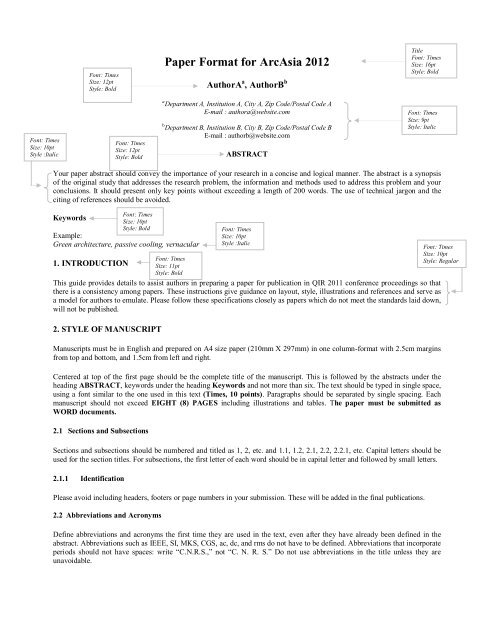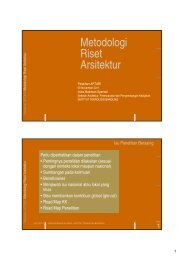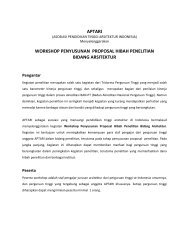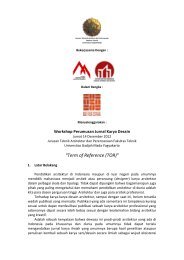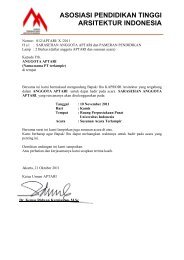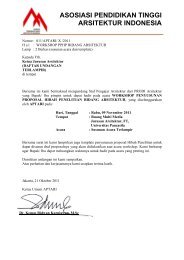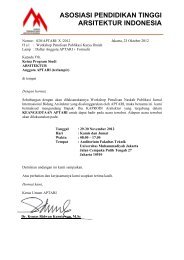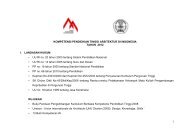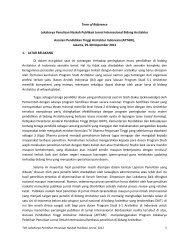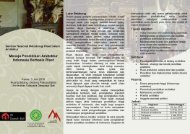Full Paper Format
Full Paper Format
Full Paper Format
You also want an ePaper? Increase the reach of your titles
YUMPU automatically turns print PDFs into web optimized ePapers that Google loves.
Font: Times<br />
Size: 10pt<br />
Style :Italic<br />
<strong>Paper</strong> <strong>Format</strong> for ArcAsia 2012<br />
AuthorA a , AuthorB b<br />
a Department A, Institution A, City A, Zip Code/Postal Code A<br />
E-mail : authora@website.com<br />
b Department B, Institution B, City B, Zip Code/Postal Code B<br />
E-mail : authorb@website.com<br />
ABSTRACT<br />
Your paper abstract should convey the importance of your research in a concise and logical manner. The abstract is a synopsis<br />
of the original study that addresses the research problem, the information and methods used to address this problem and your<br />
conclusions. It should present only key points without exceeding a length of 200 words. The use of technical jargon and the<br />
citing of references should be avoided.<br />
Keywords<br />
Font: Times<br />
Size: 12pt<br />
Style: Bold<br />
Example:<br />
Green architecture, passive cooling, vernacular<br />
1. INTRODUCTION<br />
This guide provides details to assist authors in preparing a paper for publication in QIR 2011 conference proceedings so that<br />
there is a consistency among papers. These instructions give guidance on layout, style, illustrations and references and serve as<br />
a model for authors to emulate. Please follow these specifications closely as papers which do not meet the standards laid down,<br />
will not be published.<br />
2. STYLE OF MANUSCRIPT<br />
Manuscripts must be in English and prepared on A4 size paper (210mm X 297mm) in one column-format with 2.5cm margins<br />
from top and bottom, and 1.5cm from left and right.<br />
Centered at top of the first page should be the complete title of the manuscript. This is followed by the abstracts under the<br />
heading ABSTRACT, keywords under the heading Keywords and not more than six. The text should be typed in single space,<br />
using a font similar to the one used in this text (Times, 10 points). Paragraphs should be separated by single spacing. Each<br />
manuscript should not exceed EIGHT (8) PAGES including illustrations and tables. The paper must be submitted as<br />
WORD documents.<br />
2.1 Sections and Subsections<br />
Sections and subsections should be numbered and titled as 1, 2, etc. and 1.1, 1.2, 2.1, 2.2, 2.2.1, etc. Capital letters should be<br />
used for the section titles. For subsections, the first letter of each word should be in capital letter and followed by small letters.<br />
2.1.1 Identification<br />
Font: Times<br />
Size: 12pt<br />
Style: Bold<br />
Font: Times<br />
Size: 10pt<br />
Style: Bold<br />
Please avoid including headers, footers or page numbers in your submission. These will be added in the final publications.<br />
2.2 Abbreviations and Acronyms<br />
Font: Times<br />
Size: 11pt<br />
Style: Bold<br />
Font: Times<br />
Size: 10pt<br />
Style :Italic<br />
Title<br />
Font: Times<br />
Size: 16pt<br />
Style: Bold<br />
Font: Times<br />
Size: 9pt<br />
Style: Italic<br />
Font: Times<br />
Size: 10pt<br />
Style: Regular<br />
Define abbreviations and acronyms the first time they are used in the text, even after they have already been defined in the<br />
abstract. Abbreviations such as IEEE, SI, MKS, CGS, ac, dc, and rms do not have to be defined. Abbreviations that incorporate<br />
periods should not have spaces: write “C.N.R.S.,” not “C. N. R. S.” Do not use abbreviations in the title unless they are<br />
unavoidable.
3. TABLES AND FIGURES<br />
Figures should be labeled with "Figure" and tables with "Table" and should be numbered sequentially, for example, Figure 1,<br />
Figure 2 and so on (refer to table 1 and figure 1). The figure numbers and titles should be placed below the figures, and the<br />
table numbers and titles should be placed on top of the tables. The first letter of the title should be placed in the middle of the<br />
page between the left and right margins. Tables, illustrations and the corresponding text should be placed on the same page as<br />
far as possible. Otherwise they may be placed on the immediate following page. Its size should be smaller than the type area.<br />
4. EQUATIONS<br />
Table 1: Center table captions above the tables.<br />
solvent T (°C) K2 (L mol -1 )<br />
CDCl3 RT 21 b<br />
CDCl3 20 57<br />
CHCl3 10 74<br />
CHCl3 20 58<br />
Figure 1: Description is placed right below the figure<br />
When numbering equations, enclose numbers in parentheses and place flush with right-hand margin of the column. Equations<br />
must be typed, not inserted.<br />
Example:<br />
Font: Times<br />
Size: 11pt<br />
Style: Bold<br />
5. CITATIONS AND REFERENCES<br />
Z = c0 + c1 X1 + c2 X2 + c3 X3 + c4 X4 (1)<br />
Number citations consecutively in square brackets [1]. The sentence punctuation follows the bracket [2]. Refer simply to the<br />
reference number, as in [3]. Do not use “Ref. [3]” or “reference [3]” except at the beginning of a sentence: “Reference [3]<br />
shows ... .”<br />
Please note that the references at the end of this document are in the preferred referencing style. Give all authors’ names; do<br />
not use “et al.” unless there are six authors or more. Use a space after authors' initials. <strong>Paper</strong>s that have not been published,<br />
even if they have been submitted for publication, should be cited as “unpublished” [4]. <strong>Paper</strong>s that have been accepted for<br />
publication should be cited as “in press” [5].<br />
Capitalize only the first word in a paper title, except for proper nouns and element symbols. For papers published in<br />
translation journals, please give the English citation first, followed by the original foreign-language citation [6].<br />
6. DISCUSSION<br />
Font: Times<br />
Size: 9 pt<br />
Style: italics<br />
Font: Times<br />
Size: 8-10 pt<br />
Use a zero before decimal points: “0.25,” not “.25.” Use “cm 3 ,” not “cc.” Indicate sample dimensions as “0.1 cm 0.2 cm,”<br />
not “0.1 0.2 cm 2 .” The abbreviation for “seconds” is “s,” not “sec.” When expressing a range of values, write “7 to 9” or “7-<br />
9,” not “7~9.” Spell units when they appear in text: “…a few henries,” not “…a few H.”
7. CONCLUSION<br />
Finally, you are responsible for language as editors will not check it. Do a spell and grammar check. This is available in Word.<br />
If English is not your native language, get a professional proof-reader to help if possible.<br />
The word “data” is plural, not singular. In American English, periods and commas are within quotation marks, like “this<br />
period.” A parenthetical statement at the end of a sentence is punctuated outside of the closing parenthesis (like this). (A<br />
parenthetical sentence is punctuated within the parentheses.) Use the word “whereas” instead of “while” (unless you are<br />
referring to simultaneous events).<br />
Prefixes such as “non,” “sub,” “micro,” “multi,” and “ultra” are not independent words; they should be joined to the words<br />
they modify, usually without a hyphen. There is no period after the “et” in the Latin abbreviation “et al.” (it is also italicized).<br />
The abbreviation “i.e.,” means “that is,” and the abbreviation “e.g.,” means “for example” (these abbreviations are not<br />
italicized).<br />
ACKNOWLEDGMENT<br />
The preferred spelling of the word “acknowledgment” in American English is without an “e” after the “g.” Use the singular<br />
heading even if you have many acknowledgments. For example: This <strong>Full</strong> <strong>Paper</strong> <strong>Format</strong> is developed from <strong>Full</strong> <strong>Paper</strong> <strong>Format</strong><br />
of The 12 th International Conference on Quality in Research (QiR), organized by Faculty of Engineering, Universitas<br />
Indonesia, in Bali, 4-7 July 2011.<br />
REFERENCES<br />
[1] D. J. Beebe, “Signal conversion (Book style with paper title and editor),” in Biomedical Digital Signal Processing, W. J. Tompkins, Ed.<br />
Englewood Cliffs, NJ: Prentice-Hall, 1993, ch. 3, pp. 61–74.<br />
[2] M. Akay, Time Frequency and Wavelets in Biomedical Signal Processing (Book style). Piscataway, NJ: IEEE Press, 1998, pp. 123–135.<br />
[3] G. B. Gentili, V. Tesi, M. Linari, and M. Marsili, “A versatile microwave plethysmograph for the monitoring of physiological<br />
parameters (Periodical style),” IEEE Trans. Biomed. Eng., vol. 49, no. 10, pp. 1204–1210, Oct. 2002.<br />
[4] V. Medina, R. Valdes, J. Azpiroz, and E. Sacristan, “Title of paper if known,” unpublished.<br />
[5] E. H. Miller, “A note on reflector arrays (Periodical style—Accepted for publication),” IEEE Trans. Antennas Propagat., in press.<br />
[6] T. Menendez, S. Achenbach, W. Moshage, M. Flug, E. Beinder, A. Kollert, A. Bittel, and K. Bachmann, “Prenatal recording of fetal<br />
heart action with magnetocardiography” (in German), Zeitschrift für Kardiologie, vol. 87, no. 2, pp. 111–8, 1998.<br />
COPYRIGHT<br />
All papers submitted must be original, unpublished work not under consideration for publication elsewhere. Authors are<br />
responsible to obtain all necessary permission for the reproduction of tables, figures and images and must be appropriately<br />
acknowledged. The paper is not defamatory; and the paper does not infringe any other rights of any third party.<br />
The authors agree that the Technical Committee’s decision on whether to publish the paper in the Conference’s proceedings<br />
shall be final. The authors should not treat any communication from the Technical Committee members who reviewed their<br />
work as an undertaking to publish the paper.<br />
Prior to final acceptance of the paper, authors are required to confirm in writing that they hold all necessary copyright for their<br />
paper and to assign this copyright to the Conference Organizer.


